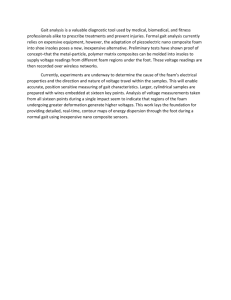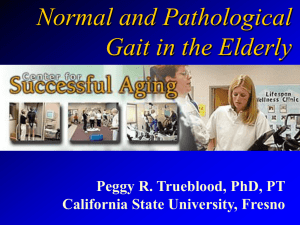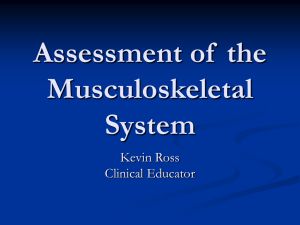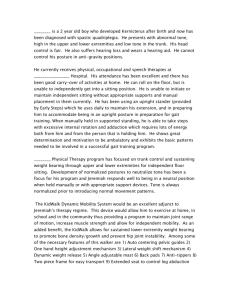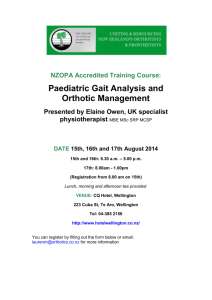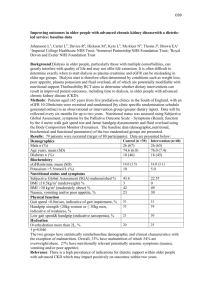A Full Body Model To Determine The Total
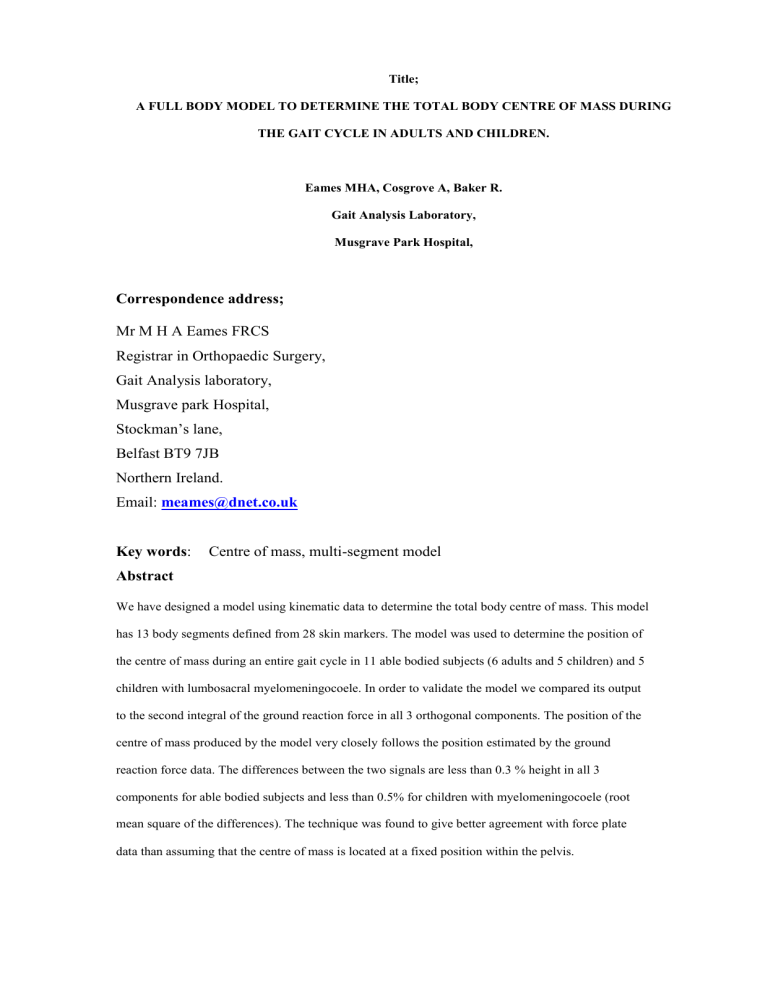
Title;
A FULL BODY MODEL TO DETERMINE THE TOTAL BODY CENTRE OF MASS DURING
THE GAIT CYCLE IN ADULTS AND CHILDREN.
Eames MHA, Cosgrove A, Baker R.
Gait Analysis Laboratory,
Musgrave Park Hospital,
Belfast
Correspondence address;
Northern Ireland.
Mr M H A Eames FRCS
Registrar in Orthopaedic Surgery,
Gait Analysis laboratory,
Musgrave park Hospital,
Stockman’s lane,
Belfast BT9 7JB
Northern Ireland.
Email:
meames@dnet.co.uk
Key words
: Centre of mass, multi-segment model
Abstract
We have designed a model using kinematic data to determine the total body centre of mass. This model has 13 body segments defined from 28 skin markers. The model was used to determine the position of the centre of mass during an entire gait cycle in 11 able bodied subjects (6 adults and 5 children) and 5 children with lumbosacral myelomeningocoele. In order to validate the model we compared its output to the second integral of the ground reaction force in all 3 orthogonal components. The position of the centre of mass produced by the model very closely follows the position estimated by the ground reaction force data. The differences between the two signals are less than 0.3 % height in all 3 components for able bodied subjects and less than 0.5% for children with myelomeningocoele (root mean square of the differences). The technique was found to give better agreement with force plate data than assuming that the centre of mass is located at a fixed position within the pelvis.
A FULL BODY MODEL TO DETERMINE THE TOTAL BODY CENTRE OF MASS
DURING THE GAIT CYCLE IN ADULTS AND CHILDREN.
Eames MHA, Cosgrove A, Baker R.
INTRODUCTION.
The mechanical aim of walking is to move the body’s mass from one point to another. As early as 1953
Inman et al proposed that the movements of the lower limbs during walking are co-ordinated in such a way that the trajectory of the centre of mass (CM) shows as little vertical displacement as possible to conserve energy. Although this proposition has received little criticism in the academic literature there is no clear reason why it should be the case. Indeed if the body accelerates and decelerates in the direction of progression during the gait cycle then the ability to “store” the lost kinetic energy during deceleration as gravitational potential energy by raising the centre of mass may well assist energy conservation. On this analysis the excursion of the CM in the vertical direction may be seen as a consequence of its movement in the direction of progression. In order to investigate this further for both able bodied and pathological gait it is necessary to have a validated model of the trajectory of the centre of mass. This paper reports the model we have developed.
There are several ways of determining the trajectory of the CM in three dimensions. One is to doubly integrate the three components of the ground reaction force with respect to time.
CM i
t
F m i .
dt
Where F i
(i = x, y, z) is the i th component of the ground reaction force, m is the total body mass and t is time.
This requires a subject to hit force plates, which can be difficult for those with a pathological gait pattern. In a laboratory with only two force plates it is not possible to get real data for a whole gait cycle as the force under the other leg during two of the three periods of double support recorded is not known (although Whittle has proposed a technique for manipulating the data to estimate the force over a single gait cycle). The integration method is subject to drift if the integration factors are not chosen accurately.
Another method, which avoids the difficulties associated with using force plates, is to assume that the
CM is a fixed point in the pelvis. In adults it is known from static studies that the CM is approximately
60%of total body height (this is known to be different in children, Hensinger 1986). An estimate of the trajectory of the CM can therefore be obtained by placing a single marker on the sacrum, or by using three markers to define a pelvis segment and defining a fixed point on this. Both these disregard the fact that the position of the CM will be influenced by the relative movement of the body segments, which can be pronounced in pathological gaits.
Whittle compared these two methods and found various discrepancies between them. Given that the force plate method is (at least conceptually) exact the discrepancy is most easily accounted as refuting the assumption that the CM can be assumed to be located at a fixed point in the pelvis.
A third possibility is to calculate the position from full body kinematics. The total body CM is the weighted sum of the CM of every segment of the body.
CM i
j m
j j
.
p i , m j j
Where m j
is the mass of segment j, and p i,j
is the i th component (i = x, y, z) of the position vector of its centre of mass.
This paper outlines how we have used this approach to design a model to determine the total body CM and validate it in able-bodied adults and children, and children with myelomeningocoele.
METHODS
We have designed a biomechanical model for calculating the CM using kinematic data. The model was written using Bodybuilder
®
software (Oxford Metrics Ltd, Oxford, England). The model defines 13 body segments from a full body set of 28 retro-reflective markers (fig 1). The centre of mass of the head is defined as lying at the centroid of the two mastoid and glabellum markers. All other segment centres of mass were defined as lying a known proportion of the distance from the distal to proximal point (see Table 1) along the line of the segment.
The Helen Heyes marker set (as reported by Kadaba et al, 1990) is used to define hip, knee and ankle joint centres. Upper body markers are placed over the centre of anatomical landmarks (Table 2).The trunk CM is defined as being along the line joining the mid point of the hip joint centres to a point midway between the mastoid processes (approximately level with the body of C2 vertebra). The arms are defined as upper arm and lower arm (including hand) segments. The shoulder joint centres are defined as being 30mm inferior to the acromial markers (this distance is fixed since it was found that scaling it to height had no effect on the output of the model). The elbow joint centre is defined in the plane of the shoulder joint centre, humeral wand and lateral epicondyle marker and at the level of the lateral epicondyle marker (analogously to Kadaba’s definition of knee and ankle joint centres). Lower arm segments are defined from the elbow joint centre to a wrist joint, defined as half way between a radial styloid marker and an ulnar styloid marker.
Values for segment mass and position of CM were obtained from anthropometric tables. Dempster’s
(1955) values were used for individuals over the age of 15 years, but in order to improve the sensitivity of the model for younger children (who have large changes in body segment characteristics during development) regression equations were used to define the segments mass and position of CM (Jensen,
1986).
A gait analysis was then performed on 6 adults, (age range 22 to 35 years) and 10 children (age range 6 to 17 years). Five children had no pathology. The other 5 had lumbosacral myelomeningocoele, but were independently ambulant (2 children had S1 level lesions, 1 had L5 and 2 had L4 lesions). These children were the only 5 in a group of 55 children with myelomeningocoele that struck the force plates in such a way that the data could be used to calculate the CM. Each had the full marker set applied and was then asked to walk several times down the 8m walkway of the laboratory. Marker position was captured with a 6-camera Vicon 370
® system (Oxford Metrics Ltd, Oxford, England). Forces were measured with strain gauge force plates (AMTI Inc., Newton, MA, USA). Subject’s start points were adjusted to ensure good force plate contact. Subsequent analysis was conducted on a single representative walk from each individual.
In order to validate the model we compared the output from this model to the second integral of the ground reaction force (as described above) in each of the x, y and z co-ordinates. Each gait cycle was taken from initial left heel contact to the next left heel contact. However when the left foot made initial contact with the force plate the right foot was still in contact with the ground, but its forces were unrecordable. To achieve force data for a full gait cycle the portion of data that was recorded when the right foot was still in contact at the end of the gait cycle was moved to the beginning of the cycle
(Whittle, 1997). The subject’s weight, and then mass, was calculated from the average vertical force throughout the cycle. The acceleration was integrated once to obtain velocity and a second time to derive distance. Linear corrections were made after each integration using Whittle’s method. In the x direction mean velocity of the centre of pelvis was taken to be the velocity at heel strike.
All data was time normalised to 50 values for a gait cycle and displacement was normalised for height.
Force plate determination gives change in position of CM, rather than absolute position. The displacement obtained for both approaches was therefore offset to give a mean value of zero. Each subject’s CM calculated from force plates was compared with the CM calculated by the model.
Differences between the outputs were assessed by measuring the square root of the mean square of the differences between the signals over the entire gait cycle. The force plate determination of the CM was
also compared in this way to the position of the centre of pelvis (CP) for each individual. Statistical significance was determined using the Mann-Whitney U test.
RESULTS
The results are shown in Figure 2. The average displacements of the CM from force plate data, full body model and CP in x (forward), y (lateral) and z (up-down) co-ordinates are shown for each group.
Table 1 shows the mean and standard deviations of displacement of the CM from the full body model for the 11 able bodied subjects. Table 2 shows the differences between the full body model and the ground reaction force calculations of the position of the CM in x, y and z co-ordinates.
DISCUSSION
Most authors (Shimba 1984, Crowe 1993, Whittle 1997) believe that the second integral of the ground reaction force data is the gold standard in determining the excursion of the CM. It is for this reason that we have compared our model to the calculation of CM from the force plate data.
Using this technique to validate our model we have found very good agreement in CM in all 3 components for able-bodied adults (<0.3 % Height) and children (<0.3 % Height). We have also validated the model for children with a pathological gait (lumbosacral myelomeningocoele). We found less than 0.5 % height between the force plate determination of the CM and our model output. This relates to less than 7mm difference for a 9 or 10 year old child of average height. It is difficult to achieve marker placement accuracy better than 5 mm and so at current levels of technology it is unlikely that there could be any improvement in the accuracy of this model.
We have found no statistical significance between adults and children in total excursion of CM.
Whittle’s measurements of excursion fall within the 95% confidence limits of our results. Small differences in excursion may be due to changes in walking velocity as it is known that the total displacement of CM is very sensitive to this (Inman et al 1981).
Saina et al (1998) have also compared force plate estimation of CM to a segmental approach. They described significant differences between CM using the 2 methods (p<0.001). However the segmental approach used only lower body kinematics, and assumed the upper body to be 1 rigid segment. The
CM for the upper body was estimated from stationary data and then used to calculate the total CM during walking. The model used had only 7 segments (of which 6 were lower body), whereas our model describes 12 segments (6 upper and 6 lower body). The significant differences between force plate estimate of the CM and Saina’s model show that if using a segmental approach all major upper body segments must be included, and demonstrate the importance of arm swing, trunkal and head movements in determining the position of the CM. Saina found no statistical difference between CM calculated from their 7 segment model and a fixed point in the centre of the pelvis when studying 25 able bodied adults. They did not find any significant difference between the segmental approach and a single sacral marker. They postulated that a single sacral marker could be used interchangeably with centre of pelvis or segmental approach as an estimate of CM during gait.
We have found differences between the position of CM and the centre of pelvis. Whittle (1997), working with adult subjects also found differences. He found that the centre of pelvis had a greater displacement in all three directions, with a small phase difference in the x (fore-aft) direction. We have found similar results, however the differences in able-bodied adults are not significant. Able-bodied children have differences that are only significant at the 10% level. The more significant difference found in children is possibly due to more inter-segment movement, especially increased head, arm and trunk movements. The phase difference found by Whittle between centre of pelvis and CM in the x direction is difficult to show since we have used actual outputs and not sinusoidal approximations.
The differences between CM and centre of pelvis become statistically significant (<1%) when pathological gait is studied. These differences may be due to increased upper segment movements, many of which are compensatory for lower limb weakness. The differences between these points suggest that centre of pelvis or sacral markers cannot be used as an approximation of CM in these children.
It can be difficult to obtain clean force plate data for children with pathological gaits. This model was developed to be part of the assessment of a large group of ambulant children with myelomeningocoele.
Out of 55 children assessed only the 6 in this study struck the force plates in such a way that their data could be used to calculate the displacement of CM. Also ground reaction force data is of no use in calculating the position of CM if the subject uses walking aids such as crutches or frames. This model allows CM to be calculated with no complex calculations from force plate data in subjects who are or are not independently ambulant.
We have used Jensen’s regression equations to calculate segment parameters for children under 15 years of age. These figures appear to give more reliable estimates of childrens’ anthropometrics than the adult work of Dempster. It should be remembered that when dealing with subjects who have abnormal body proportions errors may occur. However, our group of children with myelomeningocoele showed a large variation in percentiles for height and weight, but still had very good correlation between the model and force plate estimations of CM.
Figure 1.
2
1
0
-1
-2
0
-1
-2
2
1
0
-1
-2
2
1
Figure 2 .
Children X
50
% Gait Cycle
Children Y
50
% Gait Cycle
Children Z
50
% Gait Cycle
Fig 2. a, b, c
100
100
100
0
-1
-2
2
1
2
-1
-2
1
0
2
-1
-2
1
0
Adult X
50
% Gait Cycle
Adult Y
50
% Gait Cycle
Adult Z
50
% Gait Cycle
Fig2. d, e, f
100
100
100
Force plate estimation (grf), Full body model (CM) and centre of pelvis (CofP) plotted for normal children, adults and children with myelomeningocoele.(x: fore-aft, y: lateral, z:up-down)
0
-1
-2
2
1
2
-1
-2
1
0
0
-1
-2
2
1
Pathological Gait X
50
% Gait Cycle
Pathological Gait Y
50
% Gait Cycle
Pathological Gait Z
50
% Gait Cycle
Fig2. g, h, i
Key
100
100
100 grf
CM
CofP
Co-ordinate
Adults
Normal Children
Mean displacement in % Height
p
X
1.1 (0.4)
1.0 (0.2)
>0.1 p
(S.D.)
Y
1.6 (1.2)
1.2 (0.4)
>0.05
Z
1.9 (0.3)
1.9 (0.1) p >0.1
Mean displacement in mm for average height (S.D.)
X Y Z
21.7 (9.2)
13.5 (2.9)
-
31.3 (4.2)
15.7 (5.7)
-
37.3
(5.9)
24.2
(1.2)
-
Statistical significance
Whittle’s results (1997)
- - - 18.6
Table 1 . Displacements of CM in X, Y and Z co-ordinates
29.1 34.4
Normal Adults Normal children
Children with myelomeningocoele
Co ordinate
RMS Differences between CM calculated from GRF and Full-body model
RMS Differences between CM calculated from GRF and Centre of Pelvis
Stat Significance
p
X
0.2
(4.1)
0.3
(5.4)
>0.1 p
Y
0.3
(5.1)
0.5
(8.9)
>0.1 p
Z
0.3
(6.0)
0.4
(7.9)
>0.1 p
X
0.2
(2.9)
0.5
(6.5)
>0.05 p
Y
0.3
(3.6)
0.5
(6.5)
>0.05
(3.6)
(6.5) p>
Z
0.3
0.5
0.05
X
0.2
(2.9) p>
1.5
(20.0)
0.01
(4.9) p<
Y
0.4
1.2
(15.3)
Table 2 . Mean Root Mean Square of the differences between CM from Full-body model and Ground
0.01
0.5
(7.0)
0.8
(10.4) p=
Z
0.05 reaction force data, and of the differences between CM and Centre of Pelvis .
(Percentage height, with figures in brackets showing differences in mm for averaged sized individual).
REFERENCES;
Crowe, A, Schiereck, P, de Boer, R, Keessen, W. Characterisation of gait of young adult females by means of body centre of mass oscillations derived from ground reaction forces. Gait and posture 1993;
1: 61-68.
Dempster, WT. Space requirements of the seated operator. WADC Technical Report 55-159, Wright-
Patterson Air Force Base, OH.
Hensinger, RN (co editor). Standards in Paediatric Orthopaedics. Raven Press, NY. 1986
Inman, VT, Ralston and Todd, F. Human walking. 1981. Baltimore, MD:Williams and Wilkins.
Jensen, RK. Body segment mass, radius and radius of gyration proportions of children. J
Biomechanics . 1986; 19: 359-368.
Kadaba, MP, Ramakrishnan HK, Wooten ME. Measurement of lower extremity kinematics during level walking. J Ortho Research ; 1990: 8: 383-392.
Saina, M, Kerrigan, DC, Thirunarayan, MA, Duff-Raffaele, M. The vertical displacement of the centre of mass during walking: a comparison of four measurement methods. J Biomech Engineering . 1998;
120: 133-139.
Whittle MW. Three-dimensional motion of the centre of gravity of the body during walking. Human
Movement Science 1997; 16: 347-355.
